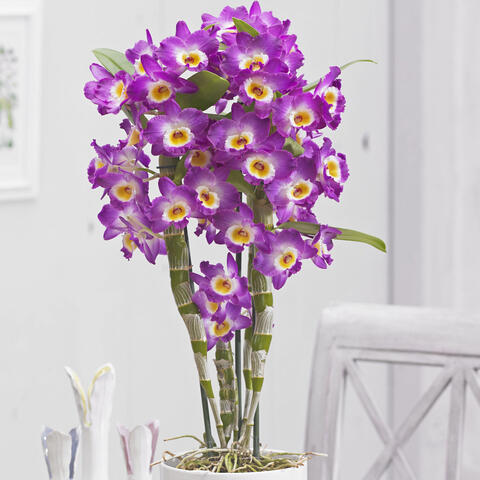Dendrobium Orchid
Dendrobium nobile is an Orchid species that not only amazes Orchid fans with its sweetly scented and lush flowers. How to plant and care for them properly.
Factsheet
- Growth type
-
- Perennial plant
- Growth height (from)
- from 30 cm to 45 cm
- Growth characteristics
-
- upright
- Kindel
- Flower color
-
- purple
- pink
- white
- Flowering time (month)
-
- February to June
- Flower shape
-
- panicles
- Flower characteristics
-
- lightly fragrant
- Leaf color
-
- green
- page format
-
- lancet-shaped
- oval
- Light
-
- scattered light
- Soil Moisture
-
- fresh to moderately humid
- ph value
-
- weakly acidic
- Lime compatibility
-
- sensitive to lime
- Nutrient requirements
-
- moderately nutritious
- Humus
-
- rich in humus
- Decorative or utility value
-
- Flower Decoration
- Use
-
- Interior greening
- Planters
- Winter garden
- Warm House
- Garden style
-
- Pot garden
Dendrobium nobile, commonly known as Dendrobium Orchid or even grape Orchid, is an Orchid species from the genus Dendrobium within the Orchid family (Orchidaceae). Dendrobium varieties are epiphytically, i.e. in their areas of origin they sit in branch forks in trees or on tree trunks. They are from the Himalayas, West Asia and Taiwan and need a dormant phase to grow and bloom.
Dendrobium nobile is a sympodial orchid. This means it forms so-called pseudobulbs, thickened shoot axes that store nutrients and water. Dendrobium grows to a height of around 11.81 to 17.71 inches and forms numerous aerial roots.
The oval leaves are lancet-shaped, arranged alternately and medium green in color with a somewhat leathery texture.
The upper leaf axis of the leafless pseudobulbs produces the panicles with numerous flowers during the flowering period between spring and fall. Similar to other Orchids the flowers of the Dendrobium also have three outer sepals, two inner petals and a third leaf shaped like a lip. The flowers appear along the entire shoot, usually two to three flowers sit shortly cut next to each other.
When you buy a Dendrobium Orchid, the plant often bears 20 to 50 wonderfully fragrant flowers. After a record flowering the plant gets 8 to 15 flowers until it has formed new bulbs after some years. The flowering period varies from three to six weeks and is usually in spring.

The Orchid species needs a bright location but should be protected from direct sunlight. Dendrobium should be placed in a bright location especially during the dormancy phase. This temperature and location is required because: The Dendrobium nobile must be kept warm during the growth phase and needs cooler temperatures for several weeks for flower induction. Therefore they can also be called ectothermic plants. During the growth phase — from spring to fall — when the new bulbs mature, high humidity with temperatures ranging from 68 to 77 degrees Fahrenheit during the day and a temperature of 59 degrees Fahrenheit at night is favorable. From mid-May to mid-October, Dendrobium Orchids are best moved outside to a covered balcony or under a parasol, where the plants are protected from rain and direct sunlight. During the dormancy phase, from fall to spring, the temperature must be between 59 to 62.6 degree Fahrenheit; at night the temperatures can even be as low as 50 degree Fahrenheit.
You must use bark substrate for all Dendrobium species. Make sure you provide a drainage layer that’s adequate. Like other Sympodial Orchids, Dendrobium is planted in the pot with the oldest shoots pointing to the edge, so that the new shoots have room to grow.
During the growing season, it is advisable to spray water on the Orchid especially when the temperatures are high outside. It is also important to water the Orchid daily with softened water until the bulbs ripen. However, let the substrate dry out again and again between the waterings. During the dormancy phase and after the bulbs have ripened, stop watering for six to eight weeks - only then new flower shoots will appear.
Every two to three weeks fertilize Dendrobium Orchids sparingly. Important: Reduce the frequency of fertilization in the dormancy phase
Repot the Dendrobium nobile only when required. The plants usually feel comfortable in very narrow containers. If there is a danger of them tipping over the windowsill, you can attach Styrofoam or wooden tiles to support them so that the pots remain vertical. Adding pebbles to the bottom of the pot could also help with the stability. However, make sure that it does not block the drainage holes.
Do not repot until the substrate is covered with algae or the Orchid has been in the same pot for more than four years. The best time for repotting is from spring to fall when new bulbs appear, but not during the dormancy period.
In general pruning is not required.

There are several Dendrobium nobile hybrids descending from the natural form, which are named after their Japanese breeder Jiro Yamamoto Yamamoto-Hybrids. Both impressively large and small varieties which do not get taller than 19.68 inches.
You can also propagate Dendrobium with Keiki. Keiki are formed from the shoot eyes on the pseudobulbs or directly on the inflorescence stem. You should let the Keiki grow on the flower stem for about a year and then gently twist it off the plant when the roots are about 1.96 inches long.
It can take up to a year from separating and replanting to the first flowering of the Keiki. Dividing the rhizome — a popular form of propagation with other sympodial orchids — should not be used as a propagation method with Dendrobium.
Too much moisture may cause a fungal infection. As with other Orchids, spider mites, mealybugs can occur when the air is too dry. If flowers don’t appear, it is a sign that the drop in temperature has not been maintained.

